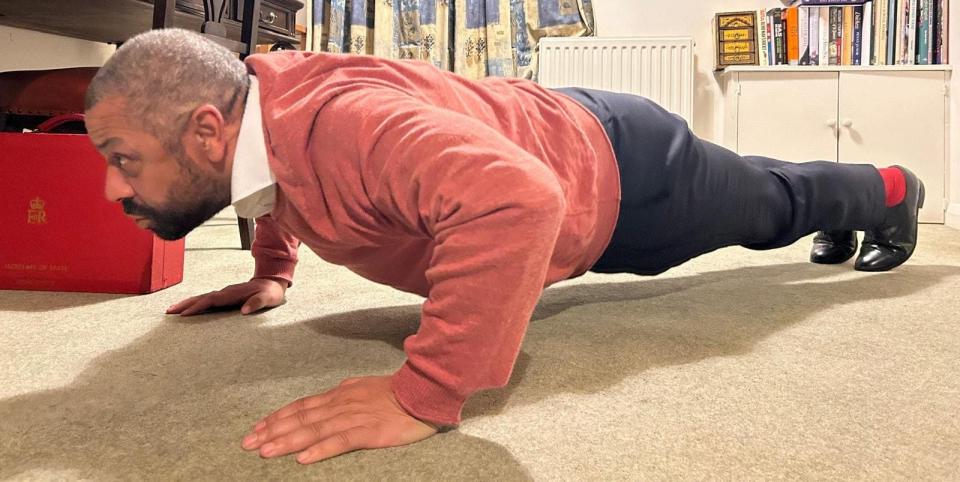It’s the exercise that is the bane of many people’s training, proving notoriously difficult to master. But perfecting your press-up (or push-up, as people often call them) form is worth it, as it can benefit your heart health as well as your strength.
The Secretary of the Interior James cleverly This week he revealed he joined thousands of others to raise money for Cancer Research UK by doing 100 every day in April, following his wife Susies breast cancer diagnosis in 2021 and completing treatment last year.
heart health
Studies suggest that rather than a measure of upper body strength, whether or not you can manage a push also reflects heart health.
Harvard University researchers monitored the health of more than 1,000 male firefighters between the ages of 21 and 66 for 10 years, including the number of push-ups they could do.
The results, published in the journal JAMA Network Open in 2019, showed there was a 96% lower risk of developing cardiovascular disease, the UK’s second biggest killer after dementia, among those who could complete 40 push-ups, compared to those who could only manage them. nine or less
This could be due to pressures that improve the function of the heart muscle by increasing the heart rate. The extra demand on the cardiovascular system to deliver oxygen and nutrients to the muscles during this exercise acts as a stimulus to strengthen the heart muscle and, as a result, will improve heart health, says Dr Derek Ball, head of sports science from the University of Aberdeen. .
Improves overall fitness
However, other exercises that involve more muscles, such as running and cycling, are better for improving the function of the cardiovascular system, he says.
Dr Richard Blagrove, Senior Lecturer in Physiology at Loughborough University, says push-ups alone will lead to negligible improvements in heart health, but are certainly a good exercise to include as part of a routine of exercises
There is a dose-response relationship between moderate and vigorous physical activity and cardiovascular health and disease risk, he explains.
The link is likely representative of those who exercise regularly (and can therefore do more push-ups) and are less likely to suffer serious illness or die younger.
Studies have repeatedly shown that being physically fit reduces the risk of heart disease, type 2 diabetes, some cancers, depression, dementia and premature death.
The ability to perform maximum repetitions of a push-up is more likely among those who lead a healthier lifestyle in general those who are more aware of their fitness, nutrition and sleep, so these behaviors and habits d ‘lifestyle will correlate with improved heart health, says Samuel Quinn. , the head of personal training at Nuffield Health.
Ultimately, if you have a stronger heart, it will deliver more oxygen to your muscles effectively, so you can power through more reps.
Muscle and bone strength
Push-ups are a form of resistance training, which has been shown to increase muscle and bone strength, as well as bone mineral density, meaning they are less likely to break.
The exercise involves the pectoral (chest), triceps (back of the arm) and anterior deltoid (front shoulder) muscles, as well as the abdominals.
These muscles are needed for everyday movements, such as standing up from a chair and lifting heavy objects overhead, Dr. Blagrove says.
In addition, push-ups can help strengthen the bones in the forearms and wrists, which are particularly vulnerable to osteoporosis. There’s a lot of load going through the arms, he says. Push-ups or exercises like push-ups should always be included as part of a strength training program.
How to make the perfect pressure
For your starting position, get into a plank position with your legs together and the soles of your feet and toes planted on the floor.
The hands should be placed slightly wider than the shoulders, with the fingers extended and pointed forward, and the arms should be straight.
There should be a straight line from the head to the shoulders. Then, begin to lower your body toward the floor keeping that straight line (tightening your glutes and abs can help with this) until your chest almost touches the floor.
Then push back until your arms are straight again.
If you’re new to strength training, you can practice against a wall or place your knees on the floor, as jumping straight into traditional push-ups can be too difficult, suggests Dr. Blagrove.
For the knee variation, place your knees on the floor instead of the balls of your feet.
If you’re doing the exercise standing, place your hands flat against the wall at chest height and slowly bring your arms in, keeping your elbows at your sides, as close to the wall as you can before moving away.
Normally 10 push-ups would make up a set.
However, Cancer Research UK’s 100 push-ups a day challenge calls for 10 times more, although you don’t have to do them in one go. It’s running throughout the month of April, but there’s nothing stopping you from getting started now, the charity encourages people to take up the challenge at any time. So far, more than 3,000 participants have raised around 250,000. More than 2,000 have been donated to the Home Secretary’s fundraising page.
recommended
The nine health benefits of regular strength training
Read more
Broaden your horizons with award-winning British journalism. Try The Telegraph free for 3 months with unlimited access to our award-winning website, exclusive app, money-saving offers and more.
#James #Cleverly #Heres #pressures #matter
Image Source : www.yahoo.com
